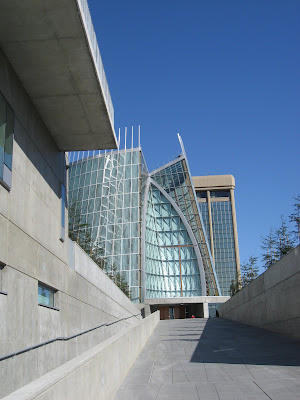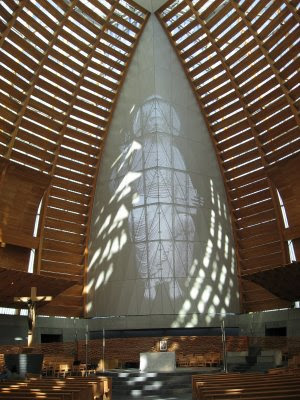
Some years ago, when I was just starting to settle into religious life, a friend sent me a card with these words penned on the reverse: “Be sure to take a day off every week. And remember, a ‘day off’ is 24 hours away from where you live and work.’” Right. At the time I thought, well, she should know better. Everyone in this country gets two days off, not one. Wrong. In religious life and ordained ministry, I quickly discovered, a single free day each week is the norm; two would be a coveted exception. With that in mind, I decided to make the most of my one free day last week to get out of Dodge (aka Sacramento), take my bicycle, and head for the Bay Area on the Capitol Corridor commuter train.
I planned to start out with Oakland, California’s new Cathedral of Christ the Light, dedicated just a few weeks ago--on September 25--and then head on to San Francisco to have lunch and maybe take in a museum. But my scheduled, cycle-by photo shoot at the Cathedral stretched unexpectedly into a three-hour visit. My quick stopover had transformed into the makings of a pilgrimage. And my initial, casual interest moved into something like awe. What happened?

After I parked my bike, I proceeded up the ramp from street-level to the cathedral plaza above. The ramp is appropriately named the Pilgrim Pathway, and with good reason. The tall, glass and steel facade, topped by spiked finials is not particularly inviting. But as one approaches and then enters the structure, one has the sense of leaving things behind and entering into a physically and spiritually transforming space. One passes through wooden doors, warm to the eye and hand onto the vestibule passage to stop at the low, expansive baptismal font.

From there, the eye is guided, quite naturally, to the soaring sanctuary beyond. Opposite, directly above the simple main altar, forming the Omega window, is the image of Christ seated in judgment taken directly from the 12th century cathedral in Chartres.

The image is transposed via computering imaging pixel by pixel—93,000 in all—onto the perforated metal surface. The light of Christ, metaphorically and literally speaking, shining through the image and into the vast, vaulted space. Ribs of Douglas fir frame and soften the environment; a sanctuary space which holds 1300 people feels surprisingly warm and intimate.

The lozenge-shaped floor plan, created by the intersection of twin circles, is repeated and compressed in the ceiling.

That’s the Big Picture. What captured my interest and captivated me most, however, were all the small, simple yet engaging details. The main sanctuary, as in many traditional cathedrals, is encompassed by an ambulatory which invites one to stroll past and into a number of quite beautiful small side chapels. Here, the overall simplicity of the project is most pronounced: slits of natural light filtering into sparsely furnished settings. Here a candle; there, a copy of Scripture lying open on a stand. An icon. Or several paintings from colonial Mexico in honor of the Holy Family. Quiet and simplicity without sterility. That’s the secret of the place. And its’ genius. And perhaps part of its appeal to at least one Franciscan.


St. Francis himself, by the way, had a great love for the Church and for church buildings as well. He once said that “We must also frequently visit churches and venerate and revere the clergy….” In reference to the Eucharist, he wrote in his Testament that “I want to have these holy mysteries honored and venerated above all things and I want to reserve them in precious places.” And his biographers mention that Francis’s enthusiam for church restoration was so great that “ he would even purchase furnishings for adorning churches, and would secretly send them to poor priests.” Legend of the Three Companions.

And Francis has given us this very short and beautiful prayer, recited by Franciscans everywhere when we gather for worship. It is a reminder to all of us of the presence of Christ in our world—a presence reflected in a very special and intimate way in the very church buildings of the Christian tradition:
“We adore You, Most Holy Lord, Jesus Christ. And we bless You. Here and in all your churches throughout the world.
Because by Your Holy Cross You have redeemed the world.”

There are most definitely some "Franciscan" touches throughout the new Oakland Cathedral. The altar stone, for example, contains relics of St. Francis, as well as those of Blessed Junipero Serra (presidente of the California missions), as well as those of St. Colette of Corbi (1381-1447) a Poor Clare nun who established reform monasteries throughout Europe. Soil from the Auschwitz concentration camp was included into the stone, in commemoration of St. Maximilian Kolbe, the Conventual Franciscan who was martyred there—as well as all of the victims of Nazi terror, especially our Jewish brothers and sisters.

One of the devotional chapels (the Chapel of All Saints) contains an icon tripytich written by Brother William Woeger, SFC, who oversaw the design and placement of much of the Cathedral's artwork. One panel of the icon shows St. Joseph holding in his hands the Franciscan mission church of San Jose (c.1797)—the first church of what was to become the Diocese of Oakland in 1962. Another ‘moment’ in the Cathedral I found especially moving was the chapel of the Suffering Christ, which features the corpus of a 17th century Spanish colonial figure suspended from a contemporary ‘cross’ in the shape of the letter “T”—the Greek letter “ tau “ which Francis used for his personal signature and as the emblem of the penitential movement for laypeople and religious he founded.


Aesthetics aside, the new Cathedral campus offers two especially striking components to its witness. The first is a Healing Garden, part of its ministry to assist victims of clergy sexual abuse—inspired and designed by two recovering victims themselves. Another is a free medical clinic for the uninsured sponsored by the Knights of Malta housed in the adjacent chancery office building.

Franciscan presence is evident elsewhere in the Diocese through our ministry at St. Elizabeth & Mary Help of Christians parishes, as well as our Franciscan School of Theology in Berkeley and our student residence and other houses in the East Bay. In addition, our brothers in the Conventual and Capuchin traditions offer an important presence, as do the Franciscan sisters of Philadelphia and Redwood City, as well as our lay members in the Secular Franciscans. Retired bishop John Cummins has been honorarily received into our Province of St. Barbara in appreciation for his ministry.

Quoting “Lumen Gentium”/ “Light of the Peoples” a seminal document of Vatican II, Oakland’s present Bishop Allen H. Vigneron stressed that “ the Church should be a ….sacrament—a sign and instrument… of intimate union with God and of the unity of the whole human race.” That certainly is the hope of this new center of worship, already realized in part by its beauty and presence. I went to the Cathedral for twenty minutes and stayed for nearly three hours. I look forward to returning frequently to this beautiful new space, made holy by the faith and commitment of the people of the Diocese of Oakland.//
All photos by Charles Talley, ofm, except for the Healing Garden: Skidmore, Owings & Merrill. Printed in the NY Times.
2 comments:
I look forward to seeing the cathedral myself. I'm traveling now and will be overseas next week, so it will be November before I can get there. Thanks for the insightful preview.
What a great resource!
Post a Comment